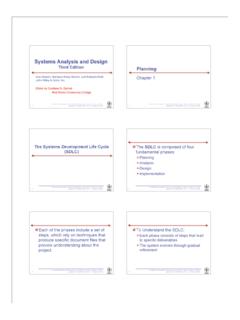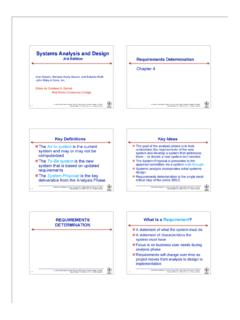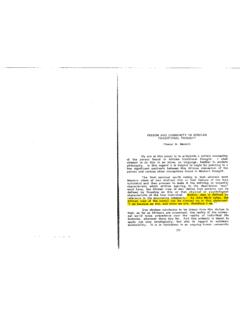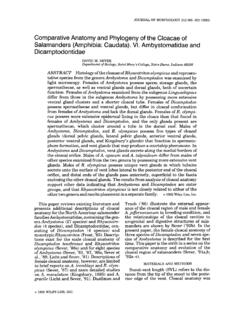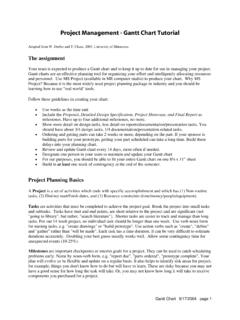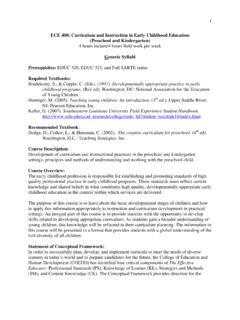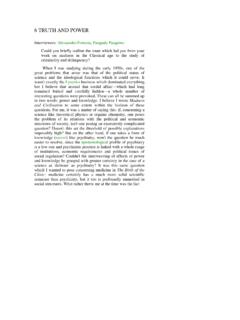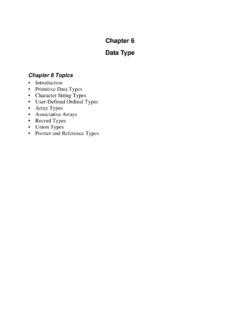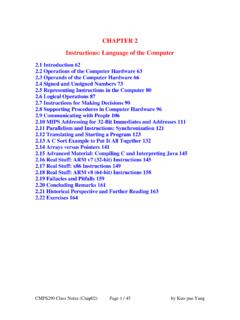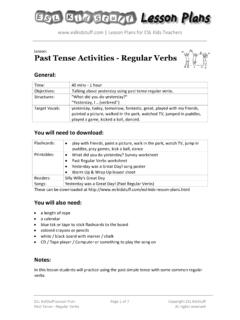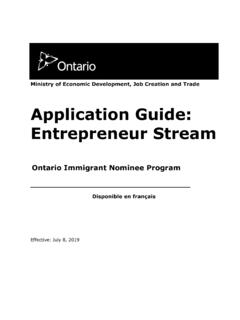Transcription of Chapter 3 Describing Syntax and Semantics
1 Chapter 3 Describing Syntax and Semantics Chapter 3 Topics Introduction The General Problem of Describing Syntax Formal Methods of Describing Syntax Describing the Meanings of Programs: Dynamic Semantics Chapter 3 Describing Syntax and Semantics Introduction Syntax the form of the expressions, statements, and program units Semantics - the meaning of the expressions, statements, and program units. Ex: while (<Boolean_expr>)<statement> The Semantics of this statement form is that when the current value of the Boolean expression is true, the embedded statement is executed. The form of a statement should strongly suggest what the statement is meant to accomplish.
2 The General Problem of Describing Syntax A sentence or statement is a string of characters over some alphabet. The Syntax rules of a language specify which strings of characters from the language s alphabet are in the language. A language is a set of sentences. A lexeme is the lowest level syntactic unit of a language. It includes identifiers, literals, operators, and special word. ( *, sum, begin) A program is strings of lexemes. A token is a category of lexemes ( , identifier.) An identifier is a token that have lexemes, or instances, such as sum and total. Ex: index = 2 * count + 17; Lexemes Tokens index identifier = equal_sign 2 int_literal * mult_op count identifier + plus_op 17 int_literal ; semicolon Language Recognizers and Generators In general, language can be formally defined in two distinct ways: by recognition and by generation.
3 Language Recognizers: o A recognition device reads input strings of the language and decides whether the input strings belong to the language. o It only determines whether given programs are in the language. o Example: Syntax analyzer part of a compiler. The Syntax analyzer, also known as parsers, determines whether the given programs are syntactically correct. Language Generators: o A device that generates sentences of a language o One can determine if the Syntax of a particular sentence is correct by comparing it to the structure of the generator Formal Methods of Describing Syntax The formal language generation mechanisms are usually called grammars Grammars are commonly used to describe the Syntax of programming languages.
4 Backus-Naur Form and Context-Free Grammars It is a Syntax description formalism that became the most widely used method for programming language Syntax . Context-free Grammars Developed by Noam Chomsky in the mid-1950s who described four classes of generative devices or grammars that define four classes of languages. Context-free and regular grammars are useful for Describing the Syntax of programming languages. Tokens of programming languages can be described by regular grammars. Whole programming languages can be described by context-free grammars. Backus-Naur Form (1959) Invented by John Backus to describe ALGOL 58 Syntax . BNF (Backus-Naur Form) is equivalent to context-free grammars used for Describing Syntax .
5 Fundamentals A metalanguage is a language used to describe another language Ex: BNF. In BNF, abstractions are used to represent classes of syntactic structures--they act like syntactic variables (also called nonterminal symbols) <assign> <var> = < expression > This is a rule; it describes the structure of an assignment statement A rule has a left-hand side (LHS) The abstraction being defined and a right-hand side (RHS) consists of some mixture of tokens, lexemes and references to other abstractions , and consists of terminal and nonterminal symbols. Example: total = sub1 + sub2 A grammar is a finite nonempty set of rules and the abstractions are called nonterminal symbols, or simply nonterminals.
6 The lexemes and tokens of the rules are called terminal symbols or terminals. A BNF description, or grammar, is simply a collection of rules. An abstraction (or nonterminal symbol) can have more than one RHS <stmt> <single_stmt> | begin <stmt_list> end Multiple definitions can be written as a single rule, with the different definitions separated by the symbol |, meaning logical OR. Describing Lists Syntactic lists are described using recursion. <ident_list> ident | ident, <ident_list> A rule is recursive if its LHS appears in its RHS. Grammars and derivations The sentences of the language are generated through a sequence of applications of the rules, beginning with a special nonterminal of the grammar called the start symbol.
7 A derivation is a repeated application of rules, starting with the start symbol and ending with a sentence (all terminal symbols) An example grammar: <program> <stmts> <stmts> <stmt> | <stmt> ; <stmts> <stmt> <var> = <expr> <var> a | b | c | d <expr> <term> + <term> | <term> - <term> <term> <var> | const An example derivation for a simple statement a = b + const <program> => <stmts> => <stmt> => <var> = <expr> => a = <expr> => a = <term> + <term> => a = <var> + <term> => a = b + <term> => a = b + const Every string of symbols in the derivation, including <program>, is a sentential form.
8 A sentence is a sentential form that has only terminal symbols. A leftmost derivation is one in which the leftmost nonterminal in each sentential form is the one that is expanded. The derivation continues until the sentential form contains no nonterminals. A derivation may be neither leftmost nor rightmost. Parse Trees Hierarchical structures of the language are called parse trees. A parse tree for the simple statement A = B + const Ambiguity A grammar is ambiguous if it generates a sentential form that has two or more distinct parse trees. Ex: Two distinct parse trees for the same sentence, const const / const <expr> <expr> <op> <expr> | const <op> / | - <expr> <expr> <expr> <expr> <expr> <expr> <expr> <expr> <expr> <expr> <op> <op> <op> <op>constconstconstconstconstconst--//<op> <program> <stmts> <stmt>consta<var>=<expr> <var>b<term>+<term> Ex.
9 Two distinct parse trees for the same sentence, A = B + A * C <assign> <id> = <expr> <id> A | B | C <expr> <expr> + <expr> | <expr> * <expr> | (<expr>) | <id> Operator Precedence The fact that an operator in an arithmetic expression is generated lower in the parse tree can be used to indicate that it has higher precedence over an operator produced higher up in the tree. In the left parsed tree above, one can conclude that the * operator has precedence over the + operator. How about the tree on the right hand side? An unambiguous Grammar for Expressions <assign> <id> = <expr> <id> A | B | C <expr> <expr> + <term> | <term> <term> <term> * <factor> | <factor> <factor> (<expr>)
10 | <id> Leftmost derivation of the sentence A = B + C * A <assing> => <id> => <expr> => A = <expr> => A = <expr> + <term> => A = <term> + <term> => A = <factor> + <term> => A = <id> + <term> => A = B + <term> => A = B + <term> * <factor> => A = B + <factor> * <factor> => A = B + <id> * <factor> => A = B + C * <factor> => A = B + C * <id> => A = B + C * A A parse tree for the simple statement, A = B + C * A Rightmost derivation of the sentence A = B + C * A <assing> => <id> => <expr> => <id> = <expr> + <term> => <id> = <expr> + <term> * <factor> => <id> = <expr> + <term> * <id> => <id> = <expr> + <term> * A => <id> = <expr> + <factor> * A => <id> = <expr> + <id> * A => <id> = <expr> + C * A => <id> = <term> + C * A => <id> = <factor> + C * A => <id> = <id> + C * A => <id> = B + C * A => A = B + C * A Both of these derivations, however, are represented by the same parse tree.
